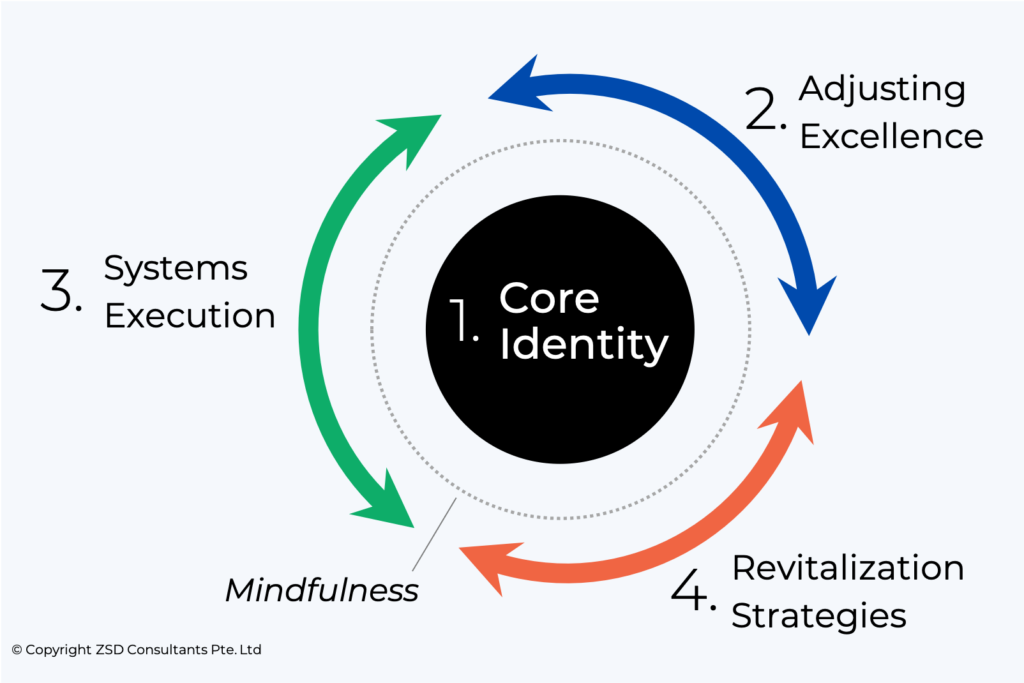“Power is influence over external events. Peace is influence over internal events.”
-James Clear
The Connective Tissue of Success
The term Mindfulness is having a bit of a moment right now. It’s the new fad, seen everywhere—at times, overused and almost at risk of becoming a meaningless cliché. That’s a shame, because the ideas and practice that underpin Mindfulness are extremely powerful. In fact, they are timeless.
In the past four articles, I introduced the Four Pillars of Sustained Success for an extraordinary life in Chiropractic. Here, I want to introduce the ‘connective tissue’ that unites the four pillars into a cohesive strategy for peak performance in your professional life: a committed Mindfulness practice.
Specifically in this article, we’ll take a detailed look at what Mindfulness is and how to begin to practice Mindfulness in your life. In the next article, we will look at how to concretely apply a Mindfulness practice to your performance in your practice. We’ll get very tactical in the next article.
Many successful Chiropractors that I know view their Mindfulness practice as a foundational life-strategy that significantly contributes to their success and fulfillment in practice.
It is so important, that Mindfulness is visually represented as a separate and distinct component of the Four Pillar model. Here’s another reminder of the model:
The Four Pillars of Sustained Success In Practice

To briefly review, the Four Pillars are:
You can review the first four parts of this opening series at the links above.
Mindfulness Defined
Mindfulness is both a practice and a state of being. Let’s discuss Mindfulness as a state of being first, and then we’ll discuss how to integrate a Mindfulness practice into your life.
Mindfulness is a way of directing your mental attention to the present moment, without judgment or critique, in order to generate a state of inner stillness and ease. Mindfulness is being in the moment, simply paying attention to what is happening inside and outside of yourself in a non-judgmental and non-reactive fashion. It is a state of present-time consciousness.
Here’s a helpful definition of Mindfulness by Jon Kabat-Zinn, one of the most prominent teachers of Mindfulness in the world.
“A curious, non-judgmental, non-reactive state of awareness to all experience in the present moment.”
-Jon Kabat-Zinn
Practicing Mindfulness helps you become more aware of:
- your thoughts,
- your emotions,
- your body sensations,
- your internal flow of energy and vibration,
- the unfolding environment around you.
Being in a state of Mindfulness will alter how you relate to the items above. You will still fully experience your thoughts, your emotions, your body sensations, etc., but you will be less driven by them. You will be less compelled to react to them.
Mindfulness allows you to observe yourself having the thoughts, feeling the emotions, experiencing the physical sensations, while giving you the space to choose how you will respond to the world. It puts you more firmly in the driver’s seat of your life, and helps you gain more dominion over your responses to external events.
Through Mindfulness, you will more effectively calm and quiet your mind by turning down the volume of your internal mental narration, and reducing the impact of your judgments, evaluations, and critiques.
As a result, you will be more ready to receive information, more able to respond constructively, and more equipped to engage with the world from a non-reactive, less-charged place.
An Introduction to Practicing Mindfulness
So, what can we do to bring the benefits of a Mindful state of awareness into our lives? It should be encouraging to know that the ability to drop in to a state of inner stillness is a skill that can be trained. By adopting a Mindfulness practice, you can get better at being Mindful, especially during the high-leverage moments of your life.
It is not only about being calm and relaxed while you are sitting on the floor, breathing. It is about helping you function optimally in your professional life by training your mind and spirit to be in the present moment, and have the resources available for you to act effectively when it counts.
Towards the end of this article, we’ll discuss specific benefits of adopting a practice of Mindfulness for the practicing Chiropractor. Let’s look at one of the single most important daily activities you can do to improve the quality of your life.
Meditation: an Essential Mindfulness Practice
The best way to cultivate Mindfulness is through a dedicated practice of meditation. There are many traditions and techniques that fall under the umbrella of meditation. Many traditions focus on the breath as an access point to the present moment. Below is a beginner-focused approach to meditation.
Sit in a comfortable position, preferably on the floor. Close your eyes and slowly breathe in, allowing the air to fill your belly. Exhale very slowly and open your awareness to your internal sensations. Connect with the movement of your breath, allow your mind to naturally slow down and grow quiet.
Breathe slowly with intention, and observe the flow of your thoughts and feelings without attachment or judgment. Inhale deeply, exhale slowly, and just be in the present moment. Breathe, gently observe, feel, and experience the present moment unfolding. Do this for as long as it feels natural and comfortable, aim for 10-20 minutes per day.
Your brain is probably hard-wired to be dominated by fight-or-flight physiology, automatically scanning your environment for ‘threats’ and cycling between reactive stimulus and response. If you are like most people, you spend a lot of time thinking about the past and worrying about the future—not being in the present moment. Meditation helps you break this habit by rewiring the connections in your brain, and re-centering your awareness to the present moment.
It will likely not feel natural at first. Don’t get discouraged if you get antsy and your mind starts to race. You might get bored or get distracted with random thoughts. That is very common when starting out. Stick with it, and I promise you will see the benefits.
The Role of the Autonomic Nerve System
From a neurological standpoint, breathing slowly, especially with a focus on slow exhalations, will activate your parasympathetic nervous system. This meditative practice stimulates the rest, relaxation, digest, and healing functions of your body. Your cycle of breathing is an access point for ease and calm to become present. Slow exhalations especially, will turn on the division of your nerve system that facilitates those things.
The simple act of becoming more aware of the rhythms of your breathing will help calm your mind and anchor yourself in the present moment more firmly. Your breath, through its effects on your nervous system, is a gateway to controlling your physiology.
Body Scanning Technique
In addition to the meditation above, you can add a technique known as body scanning.
As you are sitting, generating a state of inner stillness via slow, intentional breathing (as described above) simply focus your awareness on an area of your body, then slowly shift your awareness from one area to another.
For example, start by feeling the sensations inside of your nose. Then slowly shift your focus to the base of your skull, then to the outside of your ears, to your solar plexus, to the front of your throat, to the space between your eyes, etc. Slowly scan and hold your attention on different areas of your body. Open your awareness to the sensations that present themselves as you linger at various areas, and move slowly.
Often you will feel a sense of vibration, pulsation, or warmth as you direct your focus to different areas of your physical body. As you inhale, feel the air ‘fill’ the various areas of your body and exhale ‘through’ the body part you are focusing on. Many people experience energy flowing internally as they direct their attention to specific areas of their body.
Practice body scanning while adjusting or while you are speaking in public to drop-in to your body and feel more grounded in the moment.
Box Breathing Technique
Box breathing is a specific slow breathing technique that many people find useful to quickly generate a state of calm, ease, and stillness.
Here’s a recommended approach:
Sit in a comfortable position, preferably on the floor. Close your eyes and slowly breathe in, allowing the air to fill your belly. Slowly inhale for a count of four seconds. Hold the air in your lungs for four seconds; exhale slowly for a count of four seconds, and then hold your breath for four seconds. Do at least ten cycles of this breathing technique.
Have a look at the diagram below.

You may want to slightly increase or decrease the number of seconds per segment. As you can see, the diagram does not actually make a box, it makes a square. For some reason, the name ‘box breathing’ has stuck, so we’ll go with it.
This is a great way to start your meditation. It also a great way to tap into a state of calmness and inner stillness as you are going about your day—especially during busy, stressful moments in practice. You can do box breathing when you are stuck in traffic, waiting in line at the grocery store, or when you are in your consultation room waiting for your next appointment. It’s a great way to punctuate your day with Mindfulness and to connect with the generous present moment.
Cyclic Sighing Technique
Another proven and rapid way to slow down your heart rate, stimulate your parasympathetic nervous system, and generate a state of calm is through a breathing exercise known as Cyclic Sighing. This technique is also known as Physiological Sighing.
It is very effective for calming yourself when you are in the middle of a stressful moment.
Here’s how to do it:
- Inhale deeply through your nose. Then inhale deeply again through your nose with a sharp, quick burst. Do not exhale in between these two inhalations.
- Hold your breath for 3-8 seconds.
- Exhale naturally through your mouth as if you are sighing. Do this in a controlled, somewhat slow fashion.
Think of the three steps above as one repetition.
Do 3-10 repetitions when you are faced with a stressful situation in your practice or in your life in general. You will immediately turn off your fight-or-flight mechanism and generate more ease, peace, and calmness. This breathing technique is a way to quickly activate your parasympathetic nervous system.
Here’s a video from the @RespireOfficial YouTube channel of Dr. Andrew Huberman demonstrating this technique.
I personally like to exhale slightly more slowly than what is presented in this video. Play around with different rates of exhalation to see what works best for you.
To some, the cyclic sigh technique may not seem like a Mindfulness approach per se, but it is an accessible way to manage your levels of facilitation and excitement when you are in the midst of a stressful experience. Give it a try and see how it works for you.
I learned this technique on Dr. Andrew Huberman’s great podcast, Huberman Lab. I highly recommend his work.
Other Ways of Practicing Mindfulness
- Meditation: many traditions such as Chakra, insight, open focus meditation, etc.
- Intentional diaphragmatic breathing
- Breathing exercises: alternate nostril breathing, resonant breathing technique, etc.
- Deep, fast, over-breathing practices like the Wim Hof Method or Tummo
- Meditation for manifesting a specific outcome or emotional state
- Yogic breathing; three-part breathing
- Yoga
General Benefits of Meditation Practice
Meditation has been increasingly studied in the last decade or so and has been shown to provide profound health benefits. People that practice meditation have been shown to experience many of the following outcomes:
- Experience flow state with increased frequency.
- Experience higher levels of concentration and attention.
- Have better memory.
- Sleep better.
- Experience less fatigue.
- Respond better to stress.
- Regulate emotions more effectively.
- Have more stable moods.
- Perform better in difficult environments.
- Display positive family and parenting behaviors.
Wrapping Up
Making a Mindfulness practice like meditation a regular part of your schedule will undoubtedly add richness and meaning to your life, and very likely will help you be a more effective and impactful Chiropractor. Personally, my daily meditation sessions have become an indispensable aspect of my life. I highly recommend carving out time each day to connect with the present moment and touch the inner stillness inside of you. You won’t be disappointed with the results.
In the next article, Mindfulness in Chiropractic Practice, we’ll look at concrete and practical ways to utilize the ideas in this article to the help you excel more consistently in your practice. I’m very excited to share that article with you. Keep an eye out for it.
Something good is about to happen!
-DZ




